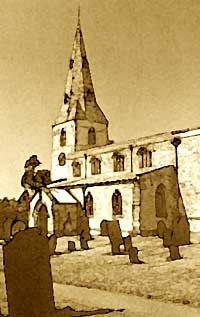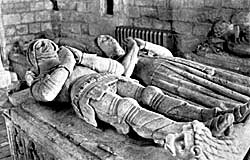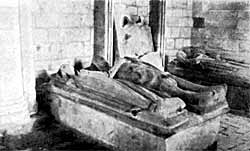Church of St. Mary, Willoughby-on-the-Wolds
By J. HOLLAND WALKER, M.B.E., F.S.A., F.R.HIST.S.

St Mary's church, Willoughby-on-the-Wolds.
ALTHOUGH the original dedication of this church is obscure, it is usually referred to as St. Mary. The fabric consists of a nave with north and south aisles, a tower and spire, a large and rather plain chancel and a chantry chapel. There is also a modern south porch which probably occupies the place of an ancient one.
Of the present building, the north and south arcades of the nave are the oldest portions, and they date to the early part of the 13th century—more or less contemporary with the signing of Magna Charta. Of these arcades the southern is a little older in fashion, and the usual explanation of the slight difference in style between it and its northern neighbour is that two unknown benefactors undertook each to build one arcade and each employed his own band of masons. This may be the true explanation, but a much more likely one is to be found in the fact that from 1208 to 1213 England was under an Interdict, during which time practically all religious activities, including church building, were suspended. The difference between these two arcades may represent this pause, the south arcade being put up just before the Interdict and the north arcade just after it.
There is nothing very much to say about the piers except that the east and west responds are keeled. The capitals are plain, but one near the south porch, for no apparent reason, is elaborately carved in a rustic fashion.

St Mary's church, Willoughby-on-the-Wolds. Effigies of Sir Hugh Willoughby (ob. 1445) and his wife, Margaret Freville.
The tower with its broached spire, rather like the Northamptonshire type of spire, comes next in date and is quickly followed by the large and plain chancel, which was rebuilt upon the old foundations about thirty or forty years ago. These date from the first half of the 14th century, about the time that Edward III arrested Roger Mortimer at Nottingham Castle. It is difficult to account for the large size of the chancel at so early a date. It is reminiscent of the earlier large chancel at Normanton-on-Soar, but at Normanton there was a cell to Durham, and a large chancel would be required for the accommodation of the monks in charge of the daughter establishment. There is no such monastic association at Willoughby. Ralph Bugge, the wealthy founder of the Willoughby family, moved from Nottingham to Willoughby just before this chancel was built, and it may be that its size represents his generosity.
In the 14th century the old aisles were replaced by the present ones which are wider than their predecessors. This additional width probably was to allow of the erection of chantry chapels or altar tombs which were coming into favour just after the Black Death, but altar tombs were never set up in these enlarged aisles, for their place was taken by the mortuary chapel of St. Nicholas.
 St Mary's church, Willoughby-on-the-Wolds. Effigies
of Sir Richard Willoughby (ob. 1325) and his wife.
St Mary's church, Willoughby-on-the-Wolds. Effigies
of Sir Richard Willoughby (ob. 1325) and his wife.In the 15th century the windows in the west end of the south aisle and both ends of the north aisle were inserted, and finally the clerestory and the roof of the nave with its enrichment of bosses was set up about the time of the Wars of the Roses.
A few relics of the past are preserved in the church. There is a little nail-head ornament at the east end of the south arcade, and on the south wall is a fragment of mural painting displaying the crossed oblongs in use during the Tudor period. Above the north arcade is another fragment of painting which does not appear to be in its original place. It is part of a coat-of-arms and under it is a fragmentary inscription in black letter which is undecipherable. As this painting displays the Tudor rose, we may perhaps assign it to the reign of Queen Elizabeth.
On the pier near the north door are a number of grooves like the well-known arrow sharpeners. It would be unusual to find arrow sharpeners inside a church, and probably the fact that a school was kept in this part of the church during the 18th century may account for these markings.
The octagonal font is not of great interest, and dates from about 1350.
